Warning: Undefined array key "style" in /home/u595483593/domains/highlinepropertyroofing.co.uk/public_html/wp-content/themes/pearl/partials/header/elements/menu/menu.php on line 79
Warning: Undefined array key "style" in /home/u595483593/domains/highlinepropertyroofing.co.uk/public_html/wp-content/themes/pearl/partials/header/elements/menu/menu.php on line 90
What Is The Best Roofing Material For A Flat Roof?
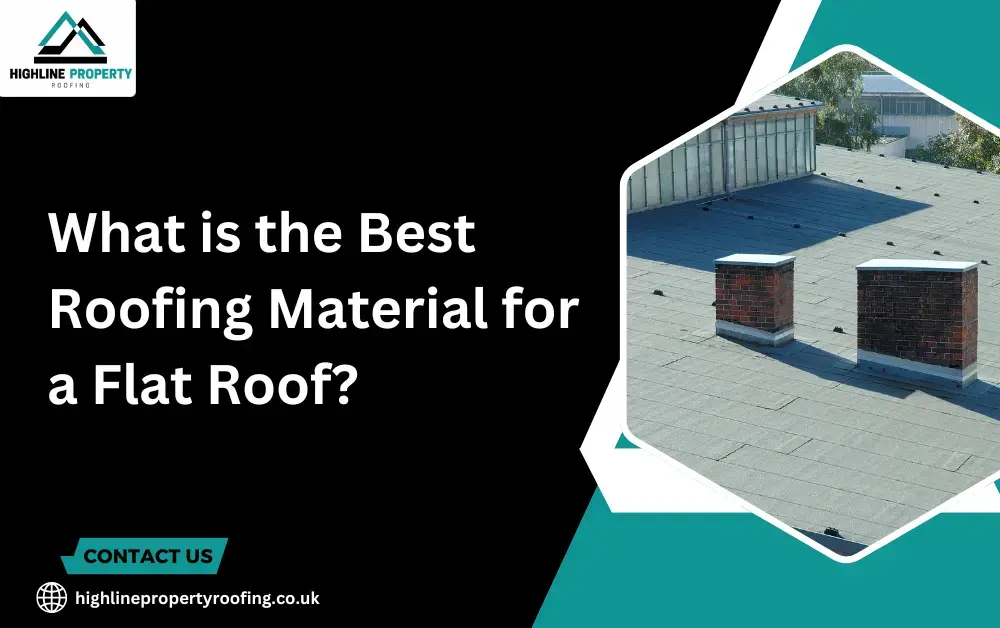
Choosing the best roofing material for flat roof is an important decision. It’s not just about picking something that “looks good”; it’s about durability, cost, weather resistance, and long-term performance. There are different types of flat roof materials that you can choose from, but the wrong choice can lead to higher costs, more maintenance, or a roof that doesn’t last as long as it should.
To help you choose the best roofing material, I have researched and compiled a guide on choosing the best roofing material for a flat roof. I have discussed important factors, like the weather in your area, the durability of different materials, and the costs involved. By understanding these points, you’ll be able to make an informed decision that fits your needs and budget.
What Is The Best Roofing Material For A Flat Roof?
1- EPDM Roofing
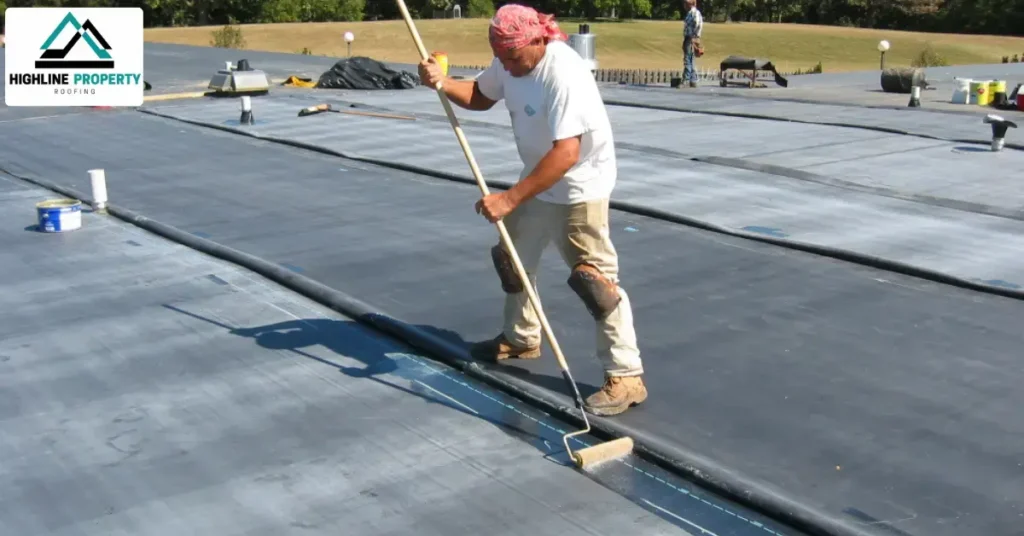
EPDM (Ethylene Propylene Diene Monomer) is a popular choice for flat or low-slope roofs, especially in both residential and commercial buildings. It’s a synthetic rubber membrane made from a combination of ethylene, propylene, and diene. Due to its flexibility, durability, and excellent weather resistance, it is the best roofing material for flat roofs.
This material is typically available in large rolls, and you can install it in one continuous piece, which can help to reduce the number of seams where leaks can occur. It is basically available in black and white, but black is the most common one.
However, you can install these flat roofs on garages, sheds, or commercial buildings where affordability, ease of installation, and durability are top priorities.
Pros of EPDM Roofing
- Highly durable: EPDM can last 25 to 30 years with proper care, which makes it a reliable long-term roofing solution.
- UV and weather resistant: It performs well in extreme weather conditions, from scorching sun to heavy rain or snow.
- Flexible material: EPDM expands and contracts with temperature changes without cracking.
- Low maintenance: It requires minimal maintenance and repairs over its lifespan.
- Cost-effective: Compared to other flat roofing systems like PVC or TPO, EPDM is usually more budget-friendly.
Cons of EPDM Roofing
- Vulnerable to punctures: Sharp tools, tree branches, or even heavy foot traffic can puncture the rubber surface, so it requires some care during installation and maintenance.
- Heat absorption: The standard black EPDM surface absorbs heat, which may increase indoor temperatures during the summer. That’s why I didn’t recommend it to you for bedroom or living area roofs.
2- TPO Roofing
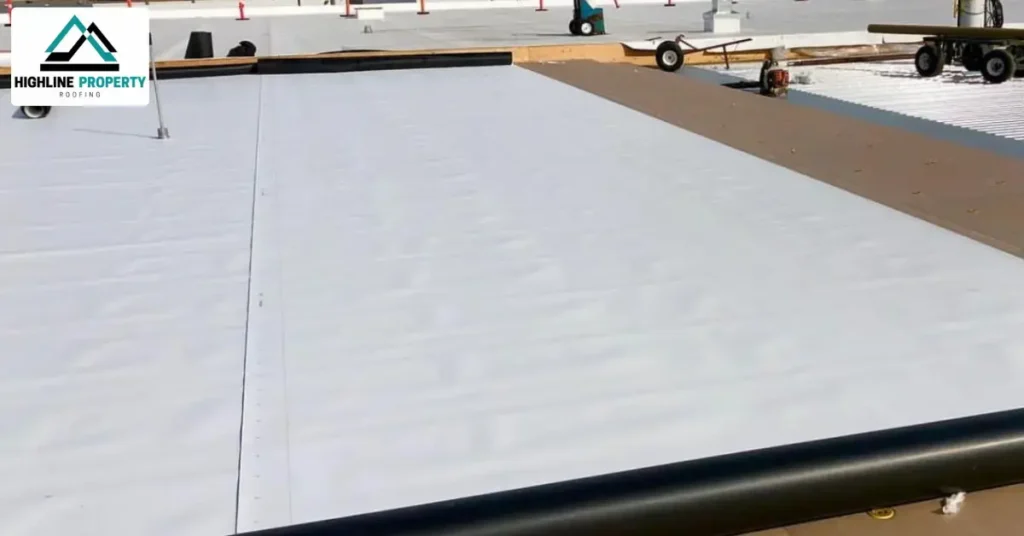
TPO (Thermoplastic Polyolefin) is a modern option of a flat roofing material. It is made from a blend of rubber and plastic (polypropylene and ethylene-propylene rubber). TPO is a single-ply membrane roofing system that is designed to offer strength, flexibility, and energy efficiency all in one.
It is lightweight, easy to install, and comes in different colours. The bright white colour of this flat roof is capable of reflecting UV rays, which can help to reduce the heat absorption and make it the best roofing material for bedrooms or living areas to keep them cooler.
Pros of TPO Roofing
- Highly energy-efficient: The white surface of TPO reflects sunlight and helps keep buildings cooler, which can significantly reduce cooling costs, especially during summers.
- UV and weather-resistant: TPO is resistant to harsh UV rays, extreme temperatures, and strong winds.
- Mould and chemical resistance: Unlike some other flat roofing materials, TPO is naturally resistant to mould, algae, and even certain chemical exposures.
- Lightweight and easy to install: TPO sheets are lightweight, which makes them easier to install than other materials.
- Fewer seams and better waterproofing: When it is installed correctly with heat-welded seams, TPO offers excellent leak resistance and a clean, seamless finish.
Cons of TPO Roofing
- Quality can vary: Not all TPO membranes are created equal. Quality depends on the manufacturer, and lower-grade products may not offer the same durability or weather resistance.
- Professional installation required: Although it’s easy to handle, TPO needs expert installation to guarantee proper heat-welded seams, which are important for preventing leaks.
- Less proven longevity: TPO is relatively newer compared to materials like EPDM, so its long-term durability may not be as time-tested, although modern versions are continuously improving.
3- PVC Roofing
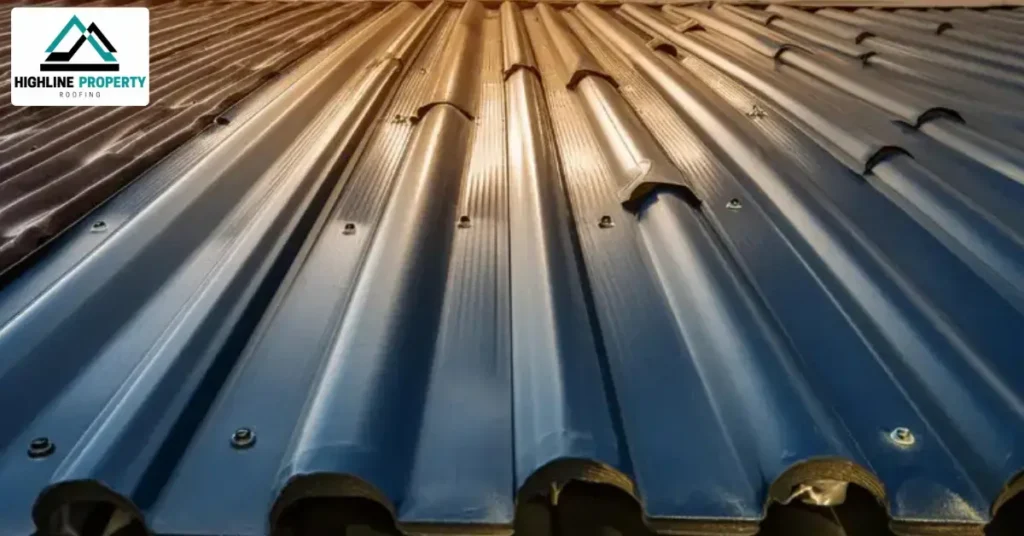
PVC (Polyvinyl Chloride) is a popular flat roofing material because of its durability. PVC is a type of single-ply membrane roofing system that has been widely used for flat roofs, especially in commercial buildings. It comes in large sheets that are easy to install with both adhesive and mechanical fasteners.
This is one of the best roofing materials for flat roofs and is known for its outstanding strength, long lifespan, and excellent resistance to chemicals, fire, and harsh weather conditions. Like TPO, PVC also reflects UV rays, which can help to reduce the heat absorption and lower the cooling costs.
Pros of PVC Roofing
- Highly durable and long-lasting: PVC roofing can easily last 25–30 years or more, which makes it a good long-term investment.
- Fire-resistant: One of the best features of PVC is its inherent fire resistance. It doesn’t support combustion, which makes it a safer option for many buildings.
- Excellent chemical resistance: PVC is highly resistant to oils, fats, fuels, and other industrial chemicals, which is best for buildings like restaurants, factories, or warehouses.
- Energy-efficient: PVC membranes are typically light-coloured or white, which helps reflect sunlight and reduces heat absorption, keeping your building cooler and helping lower your cooling bills in the summer.
- Easy maintenance and repairs: If damage occurs, repairs are relatively simple, and the material is low-maintenance overall.
Cons of PVC Roofing
- Higher upfront cost: PVC is more expensive than EPDM or TPO, both in terms of material and installation.
- Potential for shrinkage: If not installed correctly, PVC membranes can shrink over time, which may lead to pulling at seams or flashing points and increases the risk of leaks.
- Less flexible in cold temperatures: Although durable, PVC may become brittle in extremely cold climates, which can increase the risk of cracking if not properly handled or reinforced.
4- Modified Bitumen
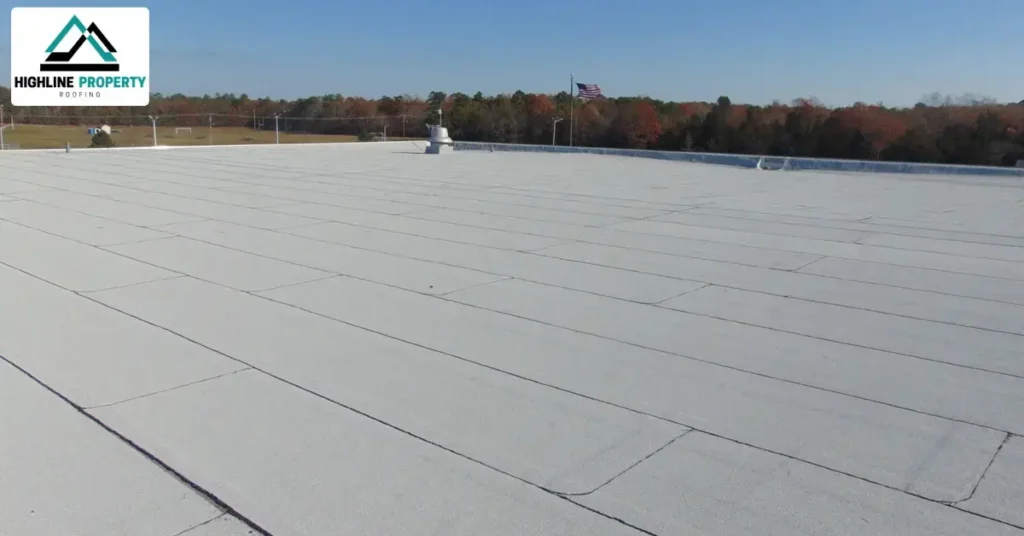
Modified Bitumen is a time-tested, asphalt-based flat roofing material that offers a balance between affordability, durability, and ease of installation. It’s essentially an enhanced version of traditional built-up roofing (BUR), reinforced with modifiers like APP (Atactic Polypropylene) or SBS (Styrene-Butadiene-Styrene) to improve its flexibility and weather resistance.
This flat roof material comes in rolls and is installed in multiple layers, either using hot torching, cold adhesives, or self-adhesive sheets; it all depends on the project requirements. It’s the best choice for you if you need it for residential extensions, garages, and commercial buildings that require a tough and cost-effective roofing solution.
Pros of Modified Bitumin
- Budget-friendly: Modified bitumen is one of the most affordable flat roofing materials, which makes it ideal for you if you are on a tight budget.
- Durable: It performs well under heavy foot traffic, which can make it suitable for roofs that require regular access for maintenance or HVAC units.
- Weather resistant: Modified bitumen can withstand moderate to harsh weather conditions, including rain, wind, and snow.
- Versatile installation methods: It offers flexibility in application, including hot-applied, cold-applied, or peel-and-stick (self-adhesive) methods, depending on the contractor’s preference and building needs.
- Waterproofing: The layered system provides reliable protection against water infiltration and reduces the risk of leaks.
Cons of Modified Bitumen
- Shorter lifespan: While reliable, it typically lasts 10–20 years, which is shorter than synthetic options like EPDM, TPO, or PVC.
- May crack in extreme temperatures: In very cold weather, bitumen can become brittle and prone to cracking, especially if the material isn’t properly maintained.
- Installation risks with torch-down method: Some versions require torch-on installation, which involves an open flame and can pose a fire hazard if not handled by professionals.
5- Built-Up Roofing
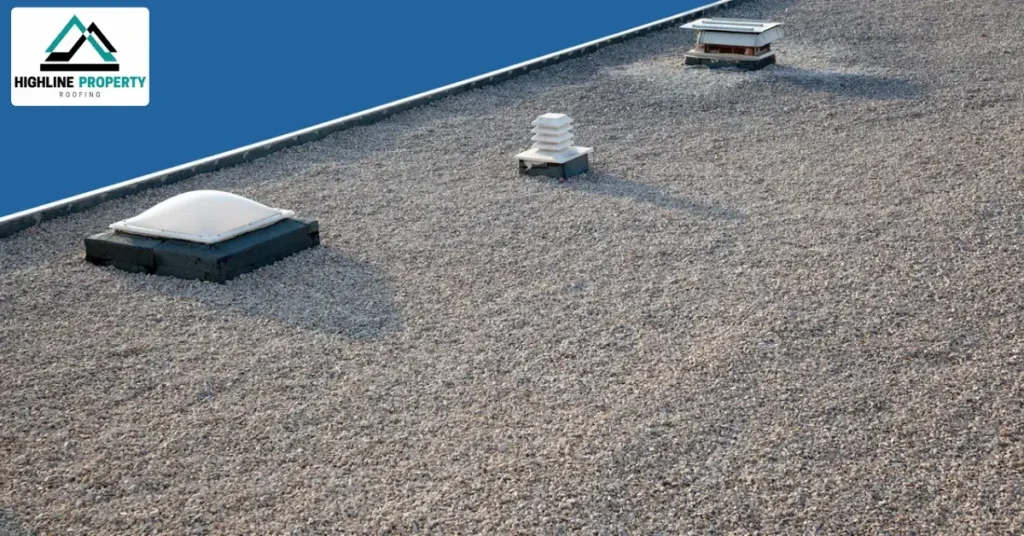
Built-up roofing (BUR) is one of the oldest and most traditional types of flat roofing systems, often referred to as a “tar and gravel roof” because its top layer is covered with small stones. As the name suggests, this roofing is built up in multiple layers, typically consisting of alternating layers of bitumen (asphalt or coal tar) that make it waterproof.
These multiple layers create a thick, strong, and waterproof barrier, which makes BUR the best roofing material for flat roofs that need long-term durability and protection from the elements. It can last about 20 to 30 years and is easy to install and repair.
Pros of BUR
- Highly durable and long-lasting: With proper installation, BUR roofs can last 20–30 years or more and offer reliable protection over the long term.
- Excellent waterproofing: The multiple layers of bitumen and fabric create a strong barrier against water leaks, even in heavy rain.
- Great insulation: BUR offers natural thermal resistance, which can help to maintain a more stable indoor temperature and improve energy efficiency.
- Low maintenance: Once installed, BUR systems generally require minimal maintenance over time.
- Good fire resistance: The gravel top layer provides added protection from fire and UV damage.
Cons of BUR
- Heavy material: BUR systems are quite heavy compared to modern alternatives, so your roof structure must be strong enough to support the weight.
- Longer installation process: BUR installation requires more labour and is time-consuming as it involves heating and layering materials on-site.
- Odour and fumes during installation: The hot tar and asphalt used during installation can produce strong, unpleasant smells and fumes, which may be inconvenient, especially in residential areas.
- Not ideal for DIY: Due to its complexity and use of heated materials, I strongly recommend professional installation.
Costs of Flat Roofing Materials
These are material and basic installation costs and may vary depending on
- Roof size and structure
- Labour charges in your area
- Access difficulties or custom requirements
- Extra elements like insulation, skylights, or drainage
| Roofing Material | Average Cost (Per m²) |
| EPDM (Rubber Roofing) | £40 – £80 |
| TPO (Thermoplastic Polyolefin) | £50 – £90 |
| PVC (Polyvinyl Chloride) | £60 – £100 |
| Modified Bitumen | £40 – £70 |
| BUR (Built-Up Roofing) | £50 – £100 |
Which Flat Roofing Material Is Best For You?
The best roofing material for your home or building depends on your budget, location, usage, and long-term needs.
If you’re looking for something affordable and low-maintenance, EPDM (rubber roofing) is the best choice. It’s easy to install, cost-effective, and lasts up to 30 years with proper care.
If you want a more energy-efficient and modern solution, TPO or PVC roofing is ideal. These materials reflect sunlight, reduce cooling costs, and offer excellent resistance to UV rays and chemicals.
If your priority is durability and traditional strength, BUR (Built-Up Roofing) or Modified Bitumen are strong options. These are time-tested options with great waterproofing properties, though they may require more effort and stronger structural support.
If you’re still confused, consult a professional roofer to find the best solution for your specific needs.
FAQs
Which flat roof material is easiest to install?
EPDM (rubber roofing) is one of the easiest and most beginner-friendly materials to install. It often comes in large sheets, reducing the number of seams and simplifying the process.
What is the average cost of a flat roof replacement?
The cost can range from £40 to £120 per square metre, depending on the material and installation method. Labour charges and roof complexity may also affect the final price.
What if I need a roof that reflects sunlight and helps with energy savings?
TPO and PVC are excellent choices for energy-efficient flat roofs. They reflect UV rays, help to keep your property cooler, and reduce energy bills in the summer.
How do I maintain a flat roof?
Maintenance is simple; just clear debris, check for cracks or pooling water, and inspect seals or joints annually. The early detection of minor issues can prevent costly repairs later.
